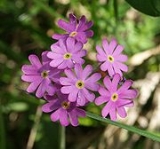
Primula farinosa
Encyclopedia
Primula farinosa, the bird's-eye primrose, is a small perennial plant
in the family Primulaceae
, native to northern Europe
and northern Asia
, and (rarely) farther south at high altitudes in the mountain
s of southern Europe. This primrose thrives on grazed meadows rich in lime and moisture.
primrose
grows from 3–20 cm in height. The leaves
are set in rosettes and are 2–10 cm long and 1–2 cm broad, smooth on top, powdery-white on the underside. The violet-blue flower
s appear in early spring, and often in rounded clusters on top of a powdery stem when the plant is older.
Perennial plant
A perennial plant or simply perennial is a plant that lives for more than two years. The term is often used to differentiate a plant from shorter lived annuals and biennials. The term is sometimes misused by commercial gardeners or horticulturalists to describe only herbaceous perennials...
in the family Primulaceae
Primulaceae
Primulaceae is a family of flowering plants with about 24 genera, including some favorite garden plants and wildflowers. It is also known as the primrose family.- Genera :...
, native to northern Europe
Europe
Europe is, by convention, one of the world's seven continents. Comprising the westernmost peninsula of Eurasia, Europe is generally 'divided' from Asia to its east by the watershed divides of the Ural and Caucasus Mountains, the Ural River, the Caspian and Black Seas, and the waterways connecting...
and northern Asia
Asia
Asia is the world's largest and most populous continent, located primarily in the eastern and northern hemispheres. It covers 8.7% of the Earth's total surface area and with approximately 3.879 billion people, it hosts 60% of the world's current human population...
, and (rarely) farther south at high altitudes in the mountain
Mountain
Image:Himalaya_annotated.jpg|thumb|right|The Himalayan mountain range with Mount Everestrect 58 14 160 49 Chomo Lonzorect 200 28 335 52 Makalurect 378 24 566 45 Mount Everestrect 188 581 920 656 Tibetan Plateaurect 250 406 340 427 Rong River...
s of southern Europe. This primrose thrives on grazed meadows rich in lime and moisture.
Growth
This small, arctic-alpineArctic-alpine
An arctic-alpine taxon is one whose natural distribution includes the Arctic and more southerly mountain ranges, particularly the Alps. The presence of identical or similar taxa in both the tundra of the far north, and high mountain ranges much further south is testament to the similar...
primrose
Primula
Primula is a genus of 400–500 species of low-growing herbs in the family Primulaceae. They include primrose, auricula, cowslip and oxlip. Many species are grown for their ornamental flowers...
grows from 3–20 cm in height. The leaves
Leaf
A leaf is an organ of a vascular plant, as defined in botanical terms, and in particular in plant morphology. Foliage is a mass noun that refers to leaves as a feature of plants....
are set in rosettes and are 2–10 cm long and 1–2 cm broad, smooth on top, powdery-white on the underside. The violet-blue flower
Flower
A flower, sometimes known as a bloom or blossom, is the reproductive structure found in flowering plants . The biological function of a flower is to effect reproduction, usually by providing a mechanism for the union of sperm with eggs...
s appear in early spring, and often in rounded clusters on top of a powdery stem when the plant is older.

